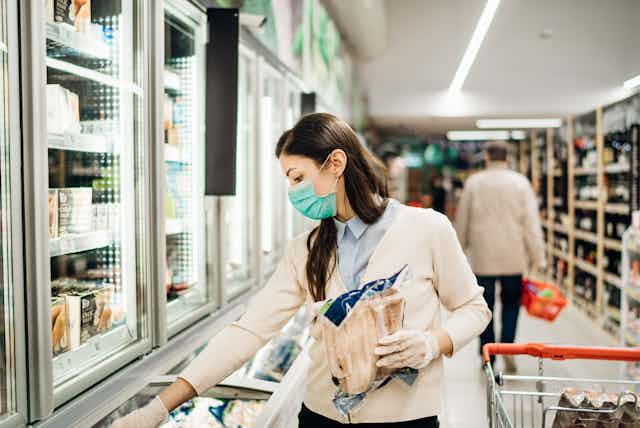Many people in the community are wearing face masks and gloves in an attempt to protect themselves against the coronavirus.
They might put on these items to go to the shops, or perhaps when taking a walk through the neighbourhood.
The evidence on whether these measures will actually protect against coronavirus is mixed and largely inconclusive.
But you’re even less likely to get protection if you don’t take care when putting on these items, while you’re wearing them, and when you take them off.
Are masks recommended?
In Australia, the Department of Health states you don’t need to wear a mask if you’re well.
People self-isolating with symptoms suspected to be COVID-19 are advised to wear a surgical face mask when other members of their household are in the same room.
This is in line with recommendations from other countries and the World Health Organisation.
Some countries, particularly those with higher rates of COVID-19 than Australia, provide different advice. The Centers for Disease Control (CDC) in the United States recommend the use of masks, or cloth face coverings, more widely.
In Hong Kong, face masks are obligatory for everyone taking public transport.
Read more: Do homemade masks work? Sometimes. But leave the design to the experts
So do masks protect against COVID-19?
We should first separate the two distinct functions of a face mask: protecting others from being infected by a wearer, and protecting the wearer from infection.
SARS-CoV-2, the coronavirus that causes COVID-19, is transmitted via droplets that fly out of our mouths or nose: most commonly when when we cough or sneeze, but also when we speak.
Most of these particles range in size between 0.3-10 micrometers. They can be directly inhaled or land on a surface where we pick them up on our hands before touching our face.
The current thinking is face masks worn by an infected person can protect the people around them by filtering at least some of these particles, particularly larger ones. This constitutes the former of the two functions, and is known as “source control”.
Read more: Coronavirus: how worried should I be about the shortage of face masks? Or can I just use a scarf?
Regarding the latter – protecting the wearer from infection – there’s some research on this, but not for COVID-19 specifically.
Evidence has shown the use of masks among health-care workers can reduce their infection with various other coronaviruses – so masks are an important element of PPE.
But for people in the community who appear to be healthy, we need more research before we can draw firm conclusions on the benefits of masks.
Are you doing it wrong?
Whatever the state of the science, some people appear to be doing things that could defeat the purpose of wearing a mask. Examples include pulling the mask under their chin for a “breather” or to make a phone call; or touching the mask while wearing it.
Through these actions, you can transfer the virus directly from your hands or your mobile phone to your face, increasing your risk of being infected.
The WHO has published some dos and don’ts for wearing face masks, summarised here:
What about gloves?
Gloves prevent the transmission of germs if used properly, and are an integral part of PPE for health-care workers.
If you’re suspected or confirmed to have COVID-19 and you’re isolating at home, Australian guidelines recommend anyone wanting to clean your room should put on a mask and gloves before entering.
However, gloves have not been recommended as a precautionary measure against COVID-19 for the average citizen. That’s largely because of the evidence we have about how the disease is, and isn’t, transmitted.
The virus is not absorbed through skin, so you can’t contract COVID-19 through touch alone. To acquire coronavirus through touch, you would have to touch a contaminated surface and then touch your face.
Although it is possible, scientists believe a much smaller proportion of infections happen this way, as compared to when an uninfected person inhales virus-carrying droplets emitted directly from an infected person.
Read more: My skin's dry with all this hand washing. What can I do?
In the US where there are much higher rates of COVID-19 than in Australia, the CDC also suggests the use of gloves only in two coronavirus-related scenarios:
if you’re cleaning and disinfecting your home where a member of the household is suspected or confirmed to have COVID-19
if you’re a health-care worker treating someone who is a suspected or confirmed COVID-19 patient.
Wear them right
While there’s no evidence to suggest wearing gloves in the community will protect you, if you do choose to wear them, there are some things you should consider.
Importantly, if you still touch your face with your gloved hands – or even touch your mobile phone – this renders the gloves useless.
And if you’re not careful, you can also contaminate your hands when you put on or take off gloves.
So follow these steps when removing gloves to reduce the risk of contaminating your hands in the process.


